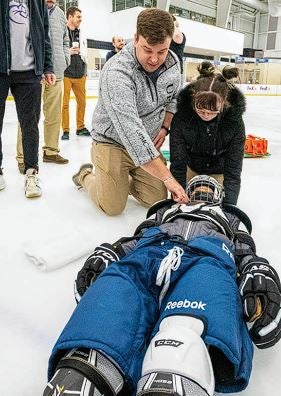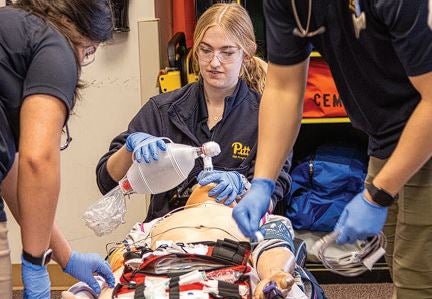AT students routinely practice spine board extrication from the pool, the gymnastics pit and on the ice
On Jan. 2, 2023, sports fans around the world held their collective breath as they watched Buffalo Bills defensive back Damar Hamlin suffer sudden cardiac arrest on the field during a Monday night football game against the Cincinnati Bengals.
What they may not realize is they were watching a highly orchestrated medical rescue—one that is rehearsed day in, day out in every sports facility in the country, from schools and community parks to colleges, universities and professional athletic venues.
Kevin Conley, associate professor and chair, Department of Sports Medicine and Nutrition, notes that every team, every facility has an emergency action plan (EAP).
Students in the Athletic Training (AT) program learn how to create EAPs as part of their coursework. “Each EAP is venue-specific,” explains Assistant Professor Amy Aggelou, AT program director. “Each venue has different equipment and resources, so AT students must understand what is available to them in each facility.”
“The ultimate goal is an effective assessment and treatment of the athlete,” says Conley. “And the key to that is prompt medical attention.”
Dr. Ronald Roth, professor of Emergency Medicine at the University of Pittsburgh School of Medicine; associate program director, Emergency Medical Services (EMS) Fellowship at SHRS; and emergency physician for the Pittsburgh Steelers, explains that prior to every NFL game, medical personnel from both teams get together an hour before kickoff for what the league calls a “60-minute meeting.”
Aggelou says it’s equivalent to a pre-competition “medical time out,” and it’s becoming a standard of care before all athletic contests, even those in middle and high schools.
Roth often leads these meetings when the Steelers play at Acrisure Stadium. “We have the entire medical staff from both teams get together and review the EAP,” he continues. “There are emergency medicine physicians, orthopedic surgeons, neurosurgeons, paramedics, X-ray technicians, airway specialists and spotters coming together to ensure they each know what they will be expected to do, what equipment will be available to them and what signals will be used to call out a medical crisis.” “This ensures that all medical personnel understand that the patient is the No. 1 priority for all of us,” adds Aggelou.
In the NFL, the airway management physician wears a red hat and typically stands on the 30- or 40-yard line. He may be one of the first medical personnel on the field when a player goes down.
“In any medical emergency that involves athletes, it’s critical that emergency medical personnel are there to support the athletic training and sports medicine staff, and vice versa,” adds Thomas E. Platt, professor and chair, Department of Community Health Services and Rehabilitation Science. “That’s one of the reasons we are committed to interprofessional education.”
AT and Emergency Medicine (EM) students have a lot to learn from each other.
“Cross-training helps us acknowledge that we have a shared skill set and allows us to be collaborative and professional when we are both on the scene of an injury,” says Platt.
He notes that in the past, AT students were required to take a first-aid course as part of their training. “Now, AT students actually become certified Emergency Medical Technicians (EMT) before their first clinical experience. Having this EMT credential benefits our students because they gain a working knowledge of how to appropriately respond to a medical crisis.”
One example is spine-boarding: the technique of transporting an individual with a suspected head, neck or spine injury. While EM students learn to become experts in spine-boarding a patient who may have been injured on the ground or in a car crash, they may not have experience extricating an injured athlete from a gymnastics pit, swimming pool or hockey rink. Athletic trainers, on the other hand, routinely practice these skills.
“ATs are also experts in removing equipment such as facemasks, helmets, jerseys and shoulder pads in an efficient and safe manner during a medical emergency,” adds Jon Andino (BS ’08, DPT ’11), assistant athletic trainer and physical therapist for the Pittsburgh Steelers. “Due to this expertise, we prefer to have the ATs remove equipment, if appropriate, prior to transporting an athlete to the hospital.”
By routinely practicing skills, students are prepared for quick action when emergencies arise
Legislation was recently introduced in the Pennsylvania State Senate that would mandate automated external defibrillators (AEDs) be present at any sporting event hosted by a school district. The proposal also calls for all coaches to complete training on the proper use of AEDs.
“On the other hand, EM personnel are accustomed to working with medical emergencies every day. In case of sudden cardiac arrest and other traumatic injuries, they become the experts on the field, taking direction from the physicians on hand,” Andino continues.
Students in both the AT and EM programs are constantly practicing their skills. “We don’t want them to wait until someone is injured to try a technique for the first time,” explains Aggelou.
“Many of these skills are required by our accrediting body,” she continues. “But it’s important to note, we don’t just meet these expectations, we exceed them. That’s what makes our program unique, and in my opinion, the best.”
SHRS Emergency Medicine students lead a simulation exercise to practice responding to a patient
Andino also serves as a clinical instructor for students in the AT program. He makes a point to have students attend EAP practice sessions so they can witness both ATs and EM personnel working together.
“Our students are able to witness how we all care for our athletes and how we work together as a medical staff with our team physicians, certified ATs, physical therapists, independent neurologists, paramedics and EMS services,” notes Andino.
“We all have the same common goal: to provide the best health care possible to our athletes.”
SPOTLIGHT ON THE SPOTTER
AT alumnus Tim Dunlavey (BS ’04) sits in the spotter’s booth at Pittsburgh Steelers’ home games. As part of his job, he reviews every play on the field multiple times looking for potential head injuries. As one of a team of spotters hired independently by the NFL, Dunlavey has the ability to communicate directly with the referees on the field and stop the game if a head injury is suspected.
SHRS WINS AT THE SUPER BOWL!
It was a big win for SHRS programs at the Super Bowl. AT alumni Rick Burkholder (BS ’87) worked the sidelines as head athletic trainer for the Kansas City Chiefs, while Joe O’Pella (BS ’07) was on duty as assistant athletic trainer for the Philadelphia Eagles. Physical Therapy alumnus Monte Wong (DPT ’05) was also on the Eagles sideline. Go Pitt!
---
Originally featured in FACETS Spring/Summer 2023 magazine.
Republished on 8/10



